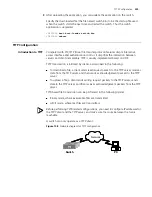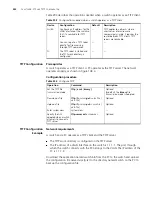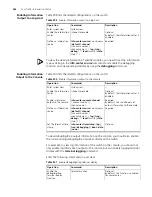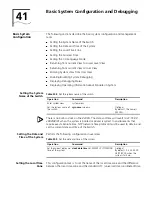
350
C
HAPTER
39: I
NFORMATION
C
ENTER
Displaying and
Debugging
Information Center
After the performing the above configurations, you can execute the
display
command in any view to display the running status of the information center, and
thus validate your configurations. You can also execute the
reset
command to clear
statistics on the information center. Make sure to execute the
reset
commands in the
User View.
Information Center
Configuration
Example
Log Output to the
Console
Network requirements
The switch sends the following information to the console: the log information of the
two modules ARP and IP, with severity higher than “informational”.
Network diagram
Figure 110
Networking for log output to the console
Configuration procedure
1
Enable the information center.
<S4200G>
system-view
[4200G]
info-center enable
2
Enable log information output to the console. Set the severity level threshold to
informational. Permit information output from the ARP and IP modules.
[4200G]
info-center console channel console
[4200G]
info-center source arp channel console log level informational
[4200G]
info-center source ip channel console log level informational
3
Enable terminal display.
<S4200G>
terminal monitor
Table 307
Display and debug information center
Operation
Command
Display the settings of one or all information
channels
display channel
[
channel
-
number |
channel
-
name
]
Display system log settings and memory
buffer record statistics
display info-center
display the status of the log buffer and the
records in the log buffer
display logbuffer
[
unit
unit-id ]
[
level
severity
|
size
buffersize
]* [ | {
begin
|
exclude
|
include }
regular-expression ]
Display summary of the log buffer
display logbuffer
summary
[
level
severity ]
Display the status of the trap buffer and the
records in the trap buffer
display trapbuffer
[
unit
unit-id ]
[
size
buffersize
]
Clear information in the log buffer
reset logbuffer
[
unit
unit-id ]
Clear information in the trap buffer.
reset trapbuffer
[
unit
unit-id ]
console
PC
Switch
console
PC
Switch
console
PC
Switch
console
PC
Switch
Summary of Contents for 4200G 12-Port
Page 10: ...8 CONTENTS...
Page 14: ...4 ABOUT THIS GUIDE...
Page 46: ...32 CHAPTER 5 LOGGING IN THROUGH WEB BASED NETWORK MANAGEMENT SYSTEM...
Page 48: ...34 CHAPTER 6 LOGGING IN THROUGH NMS...
Page 60: ...46 CHAPTER 9 VLAN CONFIGURATION...
Page 64: ...50 CHAPTER 10 MANAGEMENT VLAN CONFIGURATION...
Page 80: ...66 CHAPTER 13 GVRP CONFIGURATION...
Page 98: ...84 CHAPTER 15 LINK AGGREGATION CONFIGURATION...
Page 112: ...98 CHAPTER 18 MAC ADDRESS TABLE MANAGEMENT...
Page 126: ...112 CHAPTER 19 LOGGING IN THROUGH TELNET...
Page 162: ...148 CHAPTER 20 MSTP CONFIGURATION...
Page 274: ...260 CHAPTER 29 IGMP SNOOPING CONFIGURATION...
Page 276: ...262 CHAPTER 30 ROUTING PORT JOIN TO MULTICAST GROUP CONFIGURATION...
Page 298: ...284 CHAPTER 33 SNMP CONFIGURATION...
Page 304: ...290 CHAPTER 34 RMON CONFIGURATION...
Page 338: ...324 CHAPTER 36 SSH TERMINAL SERVICES...
Page 356: ...342 CHAPTER 38 FTP AND TFTP CONFIGURATION...
Page 365: ...Information Center Configuration Example 351 S4200G terminal logging...
Page 366: ...352 CHAPTER 39 INFORMATION CENTER...
Page 378: ...364 CHAPTER 40 BOOTROM AND HOST SOFTWARE LOADING...
Page 384: ...370 CHAPTER 41 Basic System Configuration and Debugging...
Page 388: ...374 CHAPTER 43 NETWORK CONNECTIVITY TEST...
Page 406: ...392 CHAPTER 45 CONFIGURATION OF NEWLY ADDED CLUSTER FUNCTIONS...






























